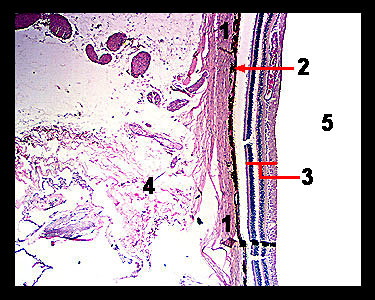|
|
|
|
||||||||||||||||||||||||||||||||||||||||||||||||||||||||||||||||||||||||||||||||||||||||||||||||||||
|
The wall of the eye consists of three major layers called tunics. The outermost layer is the fibrous tunic, which in this posterior region of the eye, consists of the sclera. The sclera is composed of densely woven collagenous fibers that make up the tough, white outer coat of the eye. Outside of the sclera is a spongy mass of orbital fatty tissue composed of loose connective tissue, fat cells, nerves and blood vessels. The middle layer of the eye wall is called the vascular tunic, which in this region is the darkly pigmented choroid. The sensory or nervous tunic consists of the retina and pigmented epithelial layer. |
|
